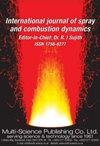涡流稳定燃烧室不稳定性的动态数据驱动预测
IF 1.4
4区 工程技术
Q3 ENGINEERING, MECHANICAL
International Journal of Spray and Combustion Dynamics
Pub Date : 2016-04-21
DOI:10.1177/1756827716642091
引用次数: 43
摘要
燃烧不稳定性对陆基和航空燃气涡轮发动机的性能和结构耐久性都有负面影响,早期发现燃烧不稳定性不仅对性能监测和故障诊断至关重要,而且对启动发动机的有效决策和控制至关重要。一般来说,燃烧不稳定性的特征是由由局部流体动力扰动、热能释放和燃烧室声学的复杂耦合引起的正反馈引起的大振幅压力音调的自我持续增长。本文提出了一种快速动态数据驱动的方法来检测热声不稳定性的早期发生,其中底层算法建立在符号时间序列分析(STSA)的概念上,通过对d -马尔可夫机结构的推广。该方法捕获了来自异质传感器(如压力和化学发光)的时间序列之间的时空共依赖关系,从而产生一个统一适用于燃烧过程的多个操作制度的信息论前兆。该方法在实验室规模的旋流稳定燃烧室生成的时间序列数据上进行了实验验证,同时在不同的空气-燃料预混水平下,各种方案(如在恒定燃料流量下增加雷诺数(Re)和在恒定空气流量下降低等效比)都会产生热声不稳定性。基础算法是基于D-Markov熵率开发的,所产生的不稳定性前驱测量在不稳定性预测、计算复杂性和对传感器噪声的鲁棒性方面与最先进的技术进行了严格的比较。本文章由计算机程序翻译,如有差异,请以英文原文为准。
Dynamic data-driven prediction of instability in a swirl-stabilized combustor
Combustion instability poses a negative impact on the performance and structural durability of both land-based and aircraft gas turbine engines, and early detection of combustion instabilities is of paramount importance not only for performance monitoring and fault diagnosis, but also for initiating efficient decision and control of such engines. Combustion instability is, in general, characterized by self-sustained growth of large-amplitude pressure tones that are caused by a positive feedback arising from complex coupling of localized hydrodynamic perturbations, heat energy release, and acoustics of the combustor. This paper proposes a fast dynamic data-driven method for detecting early onsets of thermo-acoustic instabilities, where the underlying algorithms are built upon the concepts of symbolic time series analysis (STSA) via generalization of D-Markov machine construction. The proposed method captures the spatiotemporal co-dependence among time series from heterogeneous sensors (e.g. pressure and chemiluminescence) to generate an information-theoretic precursor, which is uniformly applicable across multiple operating regimes of the combustion process. The proposed method is experimentally validated on the time-series data, generated from a laboratory-scale swirl-stabilized combustor, while inducing thermo-acoustic instabilities for various protocols (e.g. increasing Reynolds number (Re) at a constant fuel flow rate and reducing equivalence ratio at a constant air flow rate) at varying air-fuel premixing levels. The underlying algorithms are developed based on D-Markov entropy rates, and the resulting instability precursor measure is rigorously compared with the state-of-the-art techniques in terms of its performance of instability prediction, computational complexity, and robustness to sensor noise.
求助全文
通过发布文献求助,成功后即可免费获取论文全文。
去求助
来源期刊

International Journal of Spray and Combustion Dynamics
THERMODYNAMICS-ENGINEERING, MECHANICAL
CiteScore
2.20
自引率
12.50%
发文量
21
审稿时长
>12 weeks
期刊介绍:
International Journal of Spray and Combustion Dynamics is a peer-reviewed open access journal on fundamental and applied research in combustion and spray dynamics. Fundamental topics include advances in understanding unsteady combustion, combustion instability and noise, flame-acoustic interaction and its active and passive control, duct acoustics...
 求助内容:
求助内容: 应助结果提醒方式:
应助结果提醒方式:


